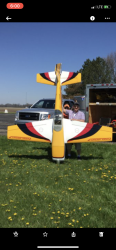
Like many hobbyists, my interest in aviation started at a very young age. It was not until high school, 38 years ago, that I had an interest in radio controlled model aviation. A classmate of mine was speaking to his friend about flying a radio controlled aircraft. From that point on, I needed to know everything I could about them.
I saved up and purchased my first one from a Hobby Shop that is long gone now. On Saturdays, the owner held a workshop behind the counter in the back of the store where customers could build the aircraft they purchased under his guidance and get help from more experienced modelers. Need glue? Go up front and get it off the shelf.
I had nobody buddy box. Not even sure they existed yet. My trainer would stand there watching, and I would have to actually hand him the transmitter as he requested if I made a mistake. We flew “two mistakes high.“ It was hard to see, but it could save your aircraft.
After getting the hang of it, I flew mostly 40-size nitro-powered aircraft for more than a decade. Mainly just flying in circles, rolls, and loops. After a while, and after watching some very experienced and very talented pilots, I became interested in aerobatics.
Using the flight simulator and practicing timidly in real life, I began with point rolls. After most of a summer performing these, it became second nature to push the sticks in the same direction when flying from inverted to the third point in the four-point roll.
Over the years, I gradually moved up in size and was flying a 50 cc, and then a 100 cc, and then a 150 cc Aircraft. I eventually owned (and still do own) a 150cc, 118-inch Carden extra 330 that was used and I got a great deal on. It was John Boyco’s old plane.
Aerobatics became a love of mine. I never was great at 3-D, but precision aerobatics offered a challenge that I could somewhat rise to. Tricks of the trade started to become second nature with hours and hours of practice.
Realizing that you are “flying the tail” of an aircraft with the Rudder stick while inverted and flying away from yourself or “Flying the nose” of an aircraft, inverted and flying towards yourself with the rudder stick, helped tremendously in corrections during maneuvers. In other words, if your aircraft is inverted and flying towards yourself, as you face it, if you push the rudder stick to your left, the nose of the aircraft will follow your stick and yaw in the same direction you are pushing the stick.
Every facet of this hobby has experts. Every RC field has people willing to help. Many future friends await those with an interest in model Aviation.
There is no shortage of camaraderie or words of advice and encouragement among fellow aviators. It is, I think, the greatest hobby!
-Mike Duggan
Kettering, Ohio


